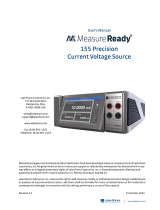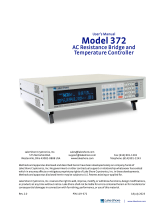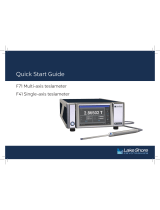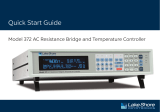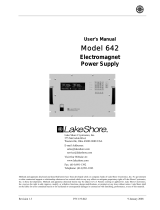Page is loading ...

Installation Instructions
Silicon Diode and GaAlAs High Temperature Sensor
DT-470/471/670/671-CU-HT and TG-120-CU-HT Package
Lake Shore Cryotronics, 575 McCorkle Blvd. Westerville, OH 43082-8888. Visit Our Website: www.lakeshore.com.
CAUTION: This temperature sensor is sensitive to electrostatic discharge (ESD). Use ESD precautionary
procedures when handling, or making mechanical or electrical connections to this device in order to avoid
performance degradation or loss of functionality.
+There are three aspects of using a cryogenic temperature sensor which are critical to its optimum performance. The first
involves the proper mounting of the sensor package. The second relates the proper joining of sensor lead wires and
connecting wires. The final concern is the thermal anchoring of the lead wires. Although the sequence in which these areas
should be addressed is not set in stone, all elements covered under each aspect should be adhered to for maximum operating
capabilities of the sensor.
SENSOR MOUNTING
The DT 470/471/670/671-CU-HT and TG-120-CU-HT package
combine a standard SD sensor with a gold-plated copper
mounting bobbin to form the CU-HT. The mounting bobbin of this
package contains a 3.1 mm (0.122 in) diameter hole (0.03 inch off
center) designed for mounting with a #4-40 or M3 screw.
1. A threaded hole in your mounting surface is necessary for
mounting the sensor package. The hole in the sensor
package will accommodate a #4-40 or M3 screw. A brass
screw is recommended due to the thermal
contractions/expansions of the final assembly.
2. The threaded hole and surrounding surface should be cleaned with a solvent such as acetone followed by an isopropyl
alcohol rinse. Allow time for the solvents to evaporate before sensor mounting.
3. For use to 500 K, apply a small amount of Apiezon® H grease to the threads of the screw. To ensure good thermal contact
between the sensor and mounting surface, use an indium washer/preform (use to 425 K only) or a thin layer of Apiezon®
H grease between the mounting surface and the sensor package. NOTE: An overabundance of grease will increase the
thermal barrier. Keep the thickness to 0.05 mm or less.
4. Insert screw through sensor mounting bobbin and tighten screw firmly enough to hold sensor in place. Avoid over
tightening (torque of 3 to 5 in-oz [0.02 to 0.035 N-M] should be sufficient).
NOTE: The high temperature -CU is designed for use up to 500 K (227°C) with a silicon diode sensor or GaAlAs diode.
Subjecting the sensor to temperature in excess of this limit will cause a shift in the sensor values.
LEAD ATTACHMENT
The SD sensor has been attached to the mounting bobbin and encapsulated in Stycast® epoxy. The 0.91 m (36 in) heavy build
Polyimide (ML) insulated sensor leads are quad twist, 36 AWG, phosphor bronze wire which are thermally anchored to the
bobbin. Teflon® tubing is used as a strain relief to reinforce the leads at the bobbin assembly. Standard lead configuration for
the CU-HT is Red (I–), Green (V–), Black or Dark Blue (V+), Clear (I+).
CU (HT) Package - Four-lead measurement scheme
The current is confined to one twisted pair of current leads with the sensor voltage measured across the twisted pair of voltage
leads as shown in Figure 1.

Thirty-six inches of Quad Twist lead wire are attached during the production process. If additional connection wire is required,
use the following instructions:
1. Prepare the sensor leads with a RMA (rosin mildly active) soldering flux, tin them with a minimal amount of solder. One
common solder that can be used to 500 K (227°C) is 90% Pb/10% Sn. Note that common 60% Sn/40% Pb or
63% Sn/37% Pb solder will melt at temperatures above ~165°C. Use a low wattage soldering iron that will not exceed
300 C. Clean off residual flux with rosin residue remover.
2. Strip the insulation from the connecting wires by delicately scraping with a razor blade, fine sand paper, or steel wool.
(Phosphor-bronze or Manganin wire, in sizes 32 or 36 AWG, is commonly used as the connecting lead wire. These wires
have low thermal conductivity which helps minimize the heat flow through the leads. For use to 500 K, polyimide or other
suitable insulation must be used on the lead extension wire. Follow the same procedure in step 1 for preparing connecting
wires.
3. Identify lead polarities and apply the soldering iron above the joint area until the solders melt; remove the iron
immediately. Leave enough slack to allow for the thermal contractions that occur during cooling which could fracture a
solder joint or lead. Insulating the soldering joint is recommended to prevent shorts. Use heat-shrink tubing rated to the
appropriate temperature to insulate the electrical joint.
HEAT SINKING/THERMAL ANCHORING
Depending on the application, sufficient heat sinking of the leads may already exist in the bobbin. Use the following procedure
if additional heat sinking is recommended. For additional heat sinking/thermal anchoring:
1. Connecting wires should be thermally anchored at several temperatures between room temperature and cryogenic
temperatures to guarantee that heat is not being conducted through the leads to the sensing element.
2. A simple thermal anchor can be made by winding the wires around a copper post, bobbin, or other thermal mass. A
minimum of five wraps around the thermal mass should provide sufficient thermal anchoring. However, if space permits,
additional wraps are recommended for good measure. To maintain good electrical isolation over many thermal cycles, it is
good practice to apply a single layer of heat sinking medium (e.g., high temperature epoxy or high temperature Stycast) to
the anchored area then wrap the wire around the paper and bond in place with an additional layer.
CRYOGENIC ACCESSORIES – Recommended for proper installation and use of DT-470/471/670/671-CU-HT and
TG-120-CU-HT Sensors:
Apiezon® Type N and H Grease. P/N GAN-25 and GAH-25 – 25 g tube. Low viscosity, easy to use, solidifies at cryogenic
temperatures, excellent lubricant. Difference is melting point: Type N is 316 K, Type H is 523 K.
Heat Sink Bobbins. P/N HSB-40 Large, HSB-8 Small. Gold-plated copper bobbins. Large bobbin holds up to 40 wires, small
bobbin holds up to 8 wires, depending on wire gauge and number of turns.
High-Temperature Solder. P/N SLT-10 – 3 m (10 ft). Greater lead content (90% Pb/10% Sn) for soldering in applications up
to 500 K.
Indium Foil/Solder. P/N IF-5 for 5 foil sheets (2 in square × 0.005 in thick), ID-10-31/ID-10-56 for 10 disks, 0.31 in or 0.56 in
diameter × 0.005 in thick, respectively. Indium is 99.99% pure, exceptional pressure seal, extremely malleable. Melting point
is 429 K (156 °C).
Ostalloy® 158 Solder. P/N SOSY-16 – 16 oz. Reusable eutectic alloy with sharply defined melting point of 343.16 K (70 °C).
Stycast® Epoxy 2850FT, Catalyst 9. P/N ES-2-20 – 20 packets, 2 g each. Permanent attachment, excellent low temperature
properties, poor electrical conductor, low cure shrinkage. Rated to 403 K (130 °C). [Requires hazardous shipping.]
VGE-7031 Varnish. P/N VGE-7031 – 0.5 L (1 pt) can. Nonpermanent attachment, excellent thermal conductor, easy to apply
and remove. Rated to 423 K (150°C). [Requires hazardous shipping.]
Instruments: Lake Shore sells a complete line of instrumentation used with your sensor, such as: current sources,
temperature controllers, monitors and thermometers, temperature scanners and transmitters.
Wire. Lake Shore offers numerous types of wires for various applications, including phosphor-bronze wires: Single Strand,
Duo-Twist™, Quad-Twist™, and Quad-Lead™, Nichrome heater wire, non-magnetic Manganin wire, and more. Use
unbonded, polyimide insulated wire for use to 500 K.
Cable. Lake Shore offers ultra-miniature coaxial cable (Type C, SC, and SS), semi-rigid coaxial cable (Type SR), and a robust
4-wire CryoCable™ (Type CYRC).
For complete product description and detailed specifications on the above accessories and instruments, consult the
Lake Shore Temperature Measurement and Control Catalog, call (614) 891-2243, e-mail at [email protected], or visit our
website at www.lakeshore.com.
Form Number F025-09-00_E ©2015 25 May 2015
/





